There are roughly 128 million households and families in the United States. Of those 128 million households, over 65 million of them own a dog, making nearly half the country dog owners.
Although it’s extremely common, buying a dog can be expensive. Therefore, it’s important to budget carefully to ensure that you can afford to buy and care for a canine companion.
In addition to being able to pay for your dog initially, you also need to set aside funds for a dog bed, food, toys, treats, and more. It’s also important to budget for future vet bills, doggy daycare, and many other expenses that are easily forgotten.
Budgeting to buy and care for a dog takes careful planning, discipline, and determination. However, once you find the dog of your dreams and give it the life it deserves, all your planning and hard work is well worth it.
So, if you’re serious about wanting to know how to budget for a dog, you’ve come to the right place.
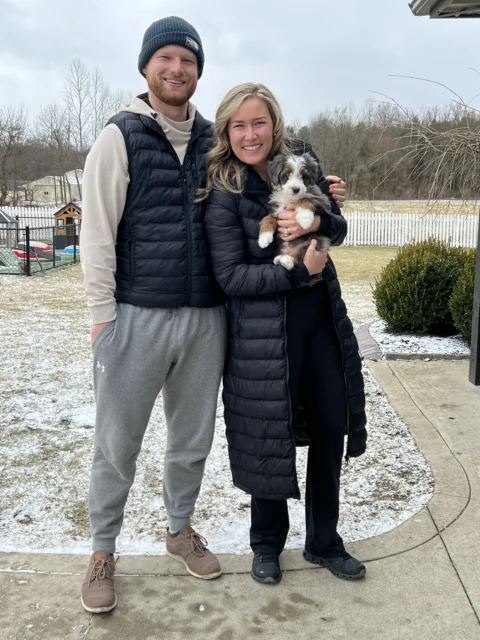
How to budget for a dog: The big picture
Like we said before, properly budgeting for a dog means taking more into account than simply the initial purchase. Let’s break down each aspect of dog ownership.
Upfront cost
How much you pay for a dog will depend on where you buy it, the breed, and many other factors. On average, however, a new dog will typically cost between $2,000 and $5,000, while some can cost as little as $500 and others can cost upwards of $7,000.
Dog food
One area where you might be tempted to save money is with dog food. However, while you don’t have to buy the most expensive brand, we strongly advise against buying the cheapest. Cheap dog food is the equivalent of eating fast food for every meal.
Therefore, we recommend paying anywhere from $50 to $100 per 25 to 35 pound bag of dog food. Depending on the type of dog you have and how big it is, you may go through one or two bags of food per month, making your monthly cost between $50 and $200.

Treats
Whether you’re training your new pup or simply want to reward them with the occasional snack, treats are a must-have for all dog owners. While you don’t have to go overboard on treats, you should expect to spend between $5 and $50 per month on dog treats.
Vet bills
One of the easiest ways to rack up massive expenses for your dog is if they have a medical condition requiring constant vet visits.
Emergency vet visits cost between $200 and $1,000 per visit, location depends a lot on that, while annual checkups and vaccinations cost around $100 to $300. So, at a minimum, you should plan for at least $100 per year for vet visits.

Groomer
Grooming is another fairly large expense that new dog owners forget about. Depending on what type of dog you get, you should expect to groom them every 6 to 8 weeks and pay $75 to $160 per grooming appointment.
This is especially true with doodle breeds, such as Goldendoodles, Bernedoodles, and Labradoodles.
Everyday supplies
There’s also plenty of everyday supplies that you’ll need to buy before or soon after you purchase your dog.
This includes things like food and water bowls, dog tags, chew toys, and more, which can easily add up to $100. Additionally, if you plan to crate train your dog, which I’d highly recommend, a crate can easily cost in excess of $75 for a mid to high-quality option.
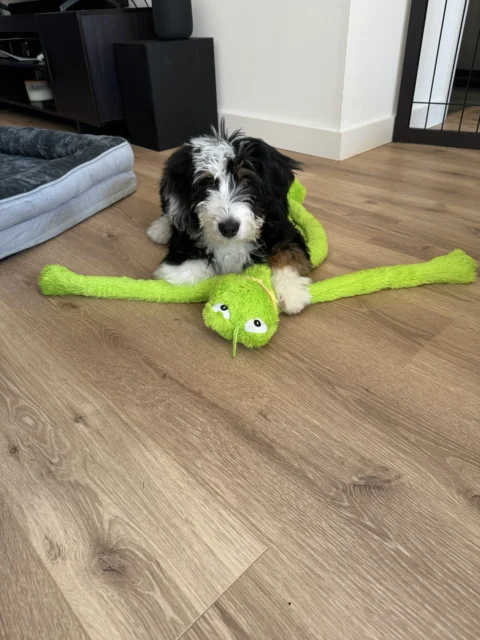
Bed
If you want your pup to feel at home when you bring them home, it’s a good idea to have a dog bed. Their bed should feel like a place of comfort and solace and is a must-have for anxious pups.
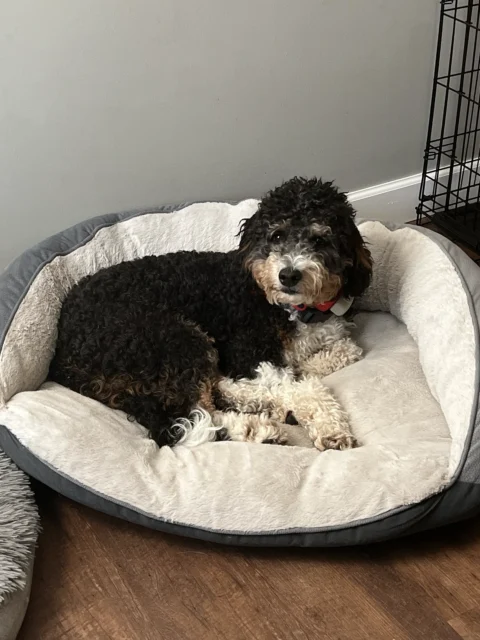
Leash and collar
Two things that your dog will absolutely need are a leash and a collar. Even if you don’t plan to take them on frequent walks because you have a large yard.
You’ll still need a collar for identifying purposes and a leash to take them to and from your vehicle for vet appointments and similar situations.
Health insurance
As with people, you have the option of purchasing health insurance for your dog. This can cost anywhere from $10 to $100 per month, depending on your insurance provider.
While this might seem like an unnecessary cost, you’ll be thanking your lucky stars you have pet insurance if they require emergency surgery or treatment of any kind.
Fencing
Although it’s completely optional, installing an above-ground or invisible fence around your yard will cost hundreds to thousands of dollars. While fencing is a large expense, it’s also a life-saver if you have an active dog.
Bernedoodles and Goldendoodles, for instance, require several hours of exercise each day, and having a fence will save you time and energy.
How much does it cost to purchase a dog?
Although we briefly touched on the cost of buying a dog, let’s dig a little deeper and look at factors that affect the cost of a dog.
Breed
Breed is perhaps the most significant factor that will affect how much your dog costs. Certain breeds, such as Bernedoodles, German Shepherds, Goldendoodles, Bulldogs, and others cost much more than mixed breeds and other less popular breeds.
Additionally, if you’re getting a dog as a guard dog, such as a German Shepherd or Belgian Malinois, you can expect to pay in excess of $5,000.
Even certain breeds that are common as family pets, such as Bernedoodles and Goldendoodles, will cost more than other traditional family pet breeds like Labradors and Golden Retrievers.
Bernedoodles and Goldendoodles, for instance, can cost between $2,000 and $5,500, whereas labs and retrievers typically cost 1500 or less in most cases.
Doodles are so expensive because they’re considered “designer breeds,” which is when two different breeds are specifically and deliberately bred together.
There are higher demands when it comes to designer breeding, as the selection process and criteria is typically stricter than non-designer breeds. As such, the cost is higher for the breeder, which means they must charge more for their pups.
Bernedoodle prices can also increase depending on the coat colors of a dog and whether or not they’ve undergone genetic testing.
Genetic testing is done to see whether or not a pup is at risk for inheriting diseases and medical conditions, which is a common issue with doodle breeds. Therefore, if a breeder performs genetic testing, they typically charge more for their dogs.
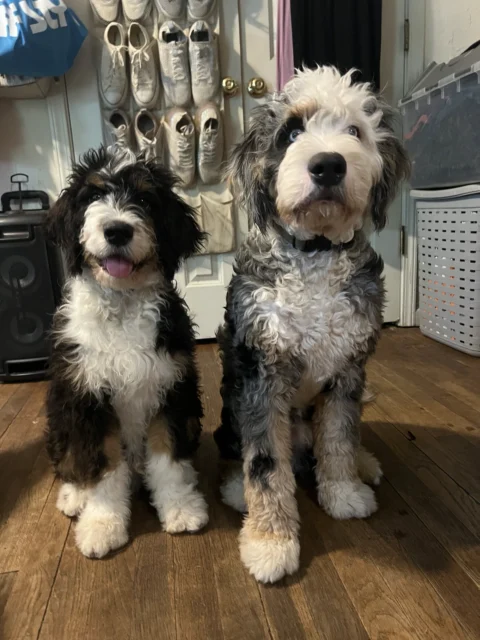
Sex
While breed can drastically affect the cost of a dog, gender typically doesn’t. Whether you prefer a male of female pup, your cost will often be the same when you’re selecting within the same litter.
Pedigree
Although it doesn’t pertain to Bernedoodles and Goldendoodles as much, pedigree plays a big role in pricing for certain other breeds. Pedigree refers to the genetics of a dog and who its parents are.
German Shepherds, for instance, can cost as little as a $1,000 or as much as $10,000 depending on the pedigree and who the parents of a litter are.
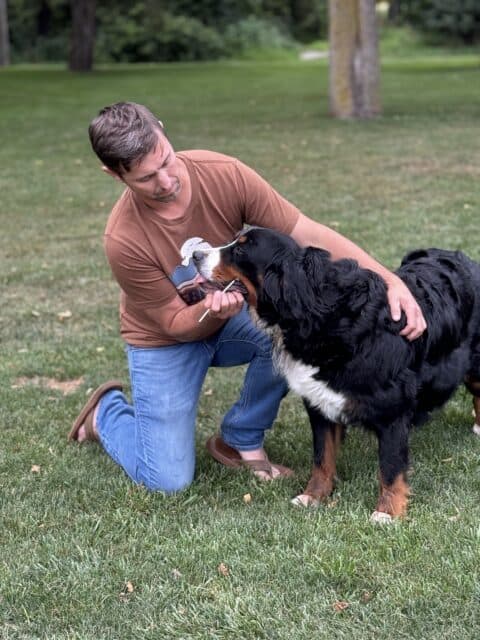
Has inflation affected the cost of buying a dog?
Inflation has affected nearly every aspect of everyday life, and dog ownership is no exception.
When you add it all up, the cost of owning a dog can be up to $1,750 per year, depending on location , how often you groom them, take them to the vet, and spend on toys, treats, and other optional things.
For instance, vet bills are higher due to inflation because vets have to pay more for their supplies, which means they need to charge you more.
The same is true of everyday items, such as dog food, toys, treats, beds, leashes, and more.
This is nearly a 55% increase from just five years ago, when the cost of owning a dog could be as low as $500 to $900 per year.
Is there a difference between large breeds and small breeds?
Whether you have a large or small breed is another thing that will affect the cost of owning a dog. In general, unless you have a small dog that’s a very rare and specific breed, large dogs will cost more than small dogs, and here’s why:
- Large dogs take longer to groom, which makes the cost per appointment higher.
- Large dogs eat more food and treats, which means you’ll have to buy more food.
- Large dogs require more exercise than small dogs, which means you’re more likely to have to install fencing.
- Large dogs tend to require more medical attention and medications through the years, which means your vet costs will be higher.
All in all, owning a large dog can cost several thousand dollars more over the lifespan of the dog than owning a small breed. Once again, this will vary from dog to dog, but that’s the general rule of thumb.

What is the typical short-term cost of owning a dog?
We’ve gone into detail about many of the short-term costs of owning a dog, such as food, treats, toys, food and water bowls, collars, and more. However, there are a few additional short-term and one-time costs to consider when it comes to dog ownership.
For instance, you have the option of microchipping your dog when you first purchase it. This can cost up to one hundred dollars, but is well worth it if you’re worried about losing your pup. Also just a note that we microchip all our puppies before they go home. Another one-time expense is if you choose to spay or neuter your dog, which can cost several hundred dollars as well.
Unless you plan to raise pups of your own, we highly recommend spaying or neutering your dog, as it often leads to better behavior and easier training. If you decide to spay or neuter your pup, it’s best to do it around the 6-month mark.
Microchipping can be done the day you take your pup home (if your puppy wasn’t chipped by the breeder) and training should begin the day you take them home. When you add it all together, the short-term cost of owning a dog can be anywhere from $2,500 to $6,000.
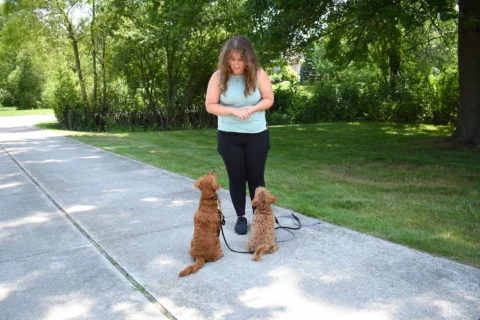
What is the typical long-term cost of owning a dog?
While the short-term cost of owning a dog is steep, the long-term costs can be much more. This is especially true if you invest in high-quality dog food, professional training, pet insurance, and other optional expenses. Here’s a rough breakdown of what your annual expenses could be:
- Professional training – Anywhere from $250 for several courses to $3,000 for a full course from a renowned trainer.
- Pet insurance – Anywhere from $500 to $2,000 per year depending on your coverage
- Vaccinations – Your dog will require annual vaccinations that can cost around $100 per visit.
- Dog food – Medium to high-quality dog food can cost $50 to $100 per bag. If you go through one bag a month, your annual cost will be $500 to $1,200.
In addition to these costs, you may also need dietary supplements for your dog.
Bernedoodles and Goldendoodles, for instance, are notorious for having poor GI systems, and they could likely benefit from probiotics and prebiotics. Add these into the mix, and your long-term cost could increase by several thousand dollars.

Does cost change if you live in the city compared to the country?
Whether you live in the country or the city can also affect the cost of dog ownership. While neither option is free, owning a dog in the city tends to cost more than in the country.
City dogs typically require more frequent grooming and veterinarians often charge more. Additionally, you’ll need to pay for doggy poop bags, dog park fees, and daycare more often in the city than in the country.
The main expense of owning a dog in the country is that you may want to install a dog fence to keep your pup on your property. Outside of this initial cost, however, there are far fewer expenses for country dogs than there are for city dogs.
Monthly cost of owning a dog
The average monthly cost of owning a dog will vary from dog to dog and owner to owner. It all depends on how much you spend on pet insurance, collars, leashes, toys, treats, and the other typical expenses.
As with human goods, there are many pet brands to choose from, and some are more expensive than others. On average, however, you should expect to pay anywhere from $40 to $400 per month, with $125 to $225 being the norm.
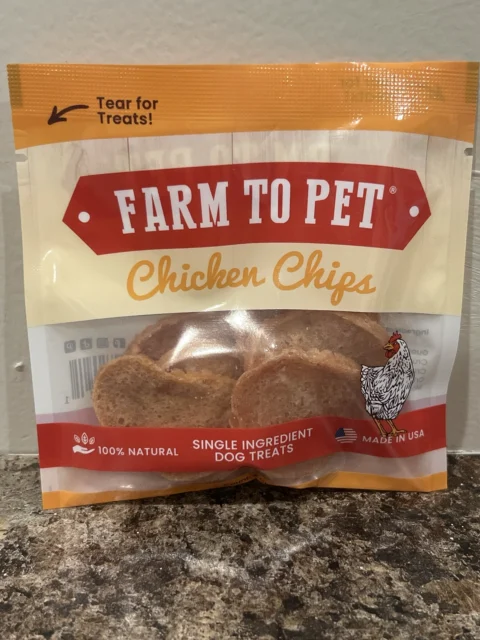
What is the typical lifetime cost of owning a dog?
If you thought that the monthly cost of owning a dog is high, that’s nothing compared to cost of ownership over the dog’s full lifespan.
To get that cost, we simply need to multiply the monthly average, $125 to $225, by the average lifespan of a dog, which is around 14 years. At $125 per month, your lifetime cost is $21,000, while at $225 per month, your lifetime cost is $37,800.
Once again, these costs will vary depending on the dog you purchase, whether or not it has health problems, and how big it is.
In general, larger dogs will have a higher lifetime cost than small dogs, because they go through more food, have more health problems, and require more vet visits.
Therefore, it’s important to think about these costs before buying a dog, as they have the potential to add up quickly.
What do people on Reddit think about how to budget for a dog?
At Fawn River Doodles, we understand firsthand the many expenses that are involved with budgeting for a dog. In addition to our expertise, however, it’s always good to hear firsthand from fellow dog owners about the types of expenses you should expect.
Here’s one firsthand account of the monthly cost of dog ownership:
“This probably varies a lot depending on breed, health, and cost of living. For our one dog (5 y/o, medium-large, healthy, but high maintenance behaviorally), we budget $150 a month for all general needs (food, supplies, toys, meds/supplements), $50 a month for vet bills (we rarely need to take her to the vet, but this also didn’t cover the full cost when she needed a tooth removed), and $125 a month for boarding when we travel. Truthfully, we only need $150 a month for the general supplies because she has a few calming supplements which are expensive.”
Here’s another firsthand account about creating a monthly budget for your dog, as well as the potential benefits of pet insurance:
“I budget $95 a month to food/treats for 2 medium/large dogs. $40 a month to vet visits (for checkups and vaccines, etc.) and meds. I’m also building a $2.5k emergency fund. My dogs are getting old and have cost me an absolute fortune the past 4-5 months … One of my pups just had cancer removed, but it’s likely to come back. Regretting not signing up for pet insurance when I had the chance. Highly suggest doing so before anything comes up that insurance can claim as a preexisting condition.”
And here are a few more, just for good measure!
“We have 2 medium dogs since they were puppies. I budget ~$65 for a 25lb bag of food every 3 weeks and a little extra here and there when they need new bones. We buy treats in bulk at Costco every 2-3 months or so which is another $40 ish. Then we spend ~$120 every 6 months on regular vet checkups and vacccines. $30 annually for both of their county licenses.”
“I’ve had a small dog for just shy of a year, and this is my current monthly budget for her –
Insurance – 31.77
Flea/Heartworm meds – 27.00
Food – 17.00
Treats/Toys/Misc – 30.00
Vet fund – 30.00″
As you can see, expenses certainly vary from dog to dog and owner to owner. It may take a few months to figure out what your expenses will be, so it’s best to budget on the high side until you know, just to be safe.
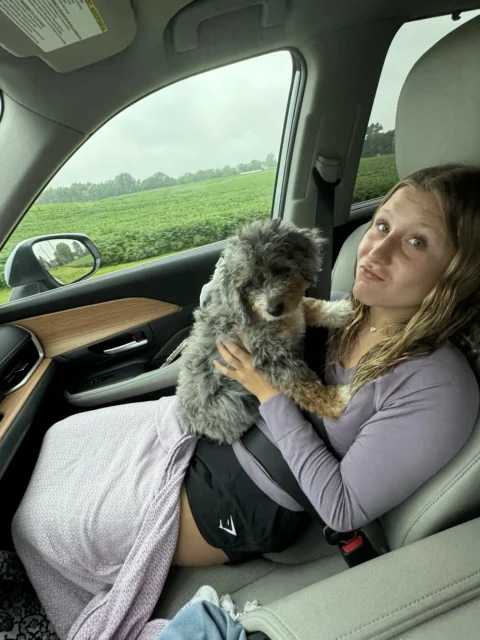
Final thoughts
As you can see, there are many different cost factors to consider when it comes to budgeting for a dog. It all starts with the initial purchase of your pup, their food, and all the things you need to make them feel at home.
However, there will also be lifelong expenses to consider, including food, grooming, vet visits, and much more.
While it’s tempting to buy a dog on a whim, it’s something you should avoid. Because of the high initial and ongoing costs of dog ownership, it’s something you should plan out in advance.
Otherwise, you may purchase a dog, not be able to care for it, and be forced to give him or her up, which is something no dog deserves.
Therefore, as long as you plan out your purchase and ensure you can provide for your pup in the long run, buying a dog is one of the most rewarding decisions you can make.

